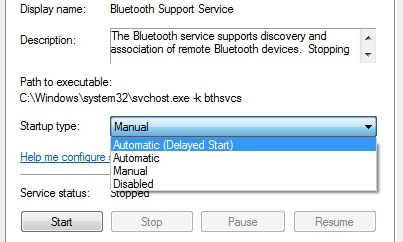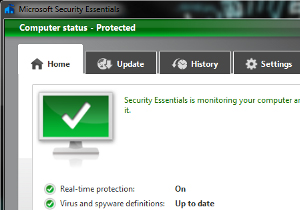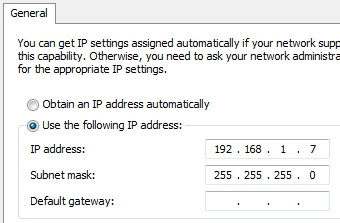Top 10 ways to speed up computer boot
If there is something that makes people uncomfortable when using a computer, it is probably restarting the computer. It may take a period of time from one or two minutes but this period of time is endless. Here are the top 10 tips to help your computer boot faster.
This seems to be a controversial topic because there are many tips for adjusting boot times. So, we did a search on the Internet and tested the easy-to-use tips, which are widely used in the online community. There are still many other tricks, some of which may be controversial, but the following 10 things will ensure that your boot time is accelerated.
10. Adjust BIOS
When installing the computer for the first time, the BIOS is set up to make things more convenient for the user. However, once installation is complete, these will be disabled. If you press and hold the DEL key when starting the computer (or any key that the BIOS requires pressing), you can turn on the " Quick Boot " mode and move the hard drive to the top of the boot - boot priority priority list. Installing Quick Boot will turn off the computer's operation checks when it first starts and adjusts the boot priority to tell the computer not to search for CDs, USB drives or other multimedia devices when booting. This will help users access the system faster. If you ever had to boot from the CD, you'll have to go back to the BIOS and change the boot priority list again.

9. Clean up software that runs at startup
One of the most commonly used ways to speed up the boot process is to remove unnecessary software from starting up with your computer. You can do this by running the msconfig command from the Start menu search box . Next, go to the Startup card. The application list here tells you what these applications do. From there, users can know which applications they should disable and which applications should keep. Besides, Soluto software is also a great way to clean up unnecessary software. Now, Soluto has many other useful features that make it worth downloading and using.
8. Delay the Windows services that run at startup
Many people argue that disabling Services from msconfig will also speed up boot time. However, we find that this way is also very troublesome. However, users can postpone some startup services so that the computer starts up faster and then uses them. After all, you don't necessarily need all these services during the boot time.

7. Change the timeout value of the Boot menu
If you are dual-boot your computer, the boot menu will have a "timeout value" message, which means the amount of time the machine waits for you to make a choice before it boots into the default operating system. In Windows, this timeout value is usually 30 seconds, a long time to wait. To change this time, re-enter msconfig and click on the BOOT.INI tab and change the value in the timeout dialog to a lower level. If you are dual-boot with the Linux operating system, you can run the GRUB boot menu and change this timeout period.
6. Disable unused hardware
Your computer loads a lot of drivers when it boots for the first time, including unused ones. Access Device Manager from the Start menu search dialog, search for any unused drivers - Bluetooth controllers, modems, and virtual Wi-Fi adapters are common culprits. Right-click the entry you want to disable and click Disable . Remember to do this only with things you really don't use anymore - if you use Wireless Hosted Networks, you'll still have to keep virtual Wi-Fi adapters enabled. Another thing to keep in mind is that keeping the updated driver will also help improve boot times. In this case, the Device Doctor application can assist you with this task.
5. Keep antivirus software active and up to date
This need not be said, anyone can understand it, but we still want to talk about it to remind users: install some antivirus software, keep it updated and scan computers periodically. This is a more natural method of protecting your computer than it is to speed up your computer. However, if your computer is infected with malware, it will certainly slow down the boot time of the computer. Using antivirus software like Microsoft Security Essentials, you will be better protected. Do not like MSE? There are still many other great antivirus software on the market and there is no reason for you not to use one of them to protect your computer and speed up boot time in some cases.

4. Remove unnecessary fonts
Windows has inherently loaded a lot of fonts at startup and this also slows down the time it takes to boot up the computer. This is not really a problem but it still slows down the boot time. Windows 7 downloads more than 200 fonts at startup and this number is even higher if you install Microsoft Office. However, if you use only a few of them, you can hide them to speed up the boot process. In Windows 7, open the Fonts folder from the Start menu search dialog and turn off all unnecessary fonts. Then, click the Hide button on the toolbar. This way, when these fonts are needed later, you can still bring them back, but Windows does not load them on startup. Note that just removing a few fonts will not create a computer startup effect so quickly that you can pay attention to it. If you want to see the effect right away, the user will probably have to hide several hundred fonts. This is not uncommon because the computer can contain a lot of fonts that you yourself don't recognize.
3. Upgrade RAM
Installing lots of RAM is often an effective way to speed up your computer. Today, the price of RAM is not too expensive, so if you find your computer running slowly, there is no reason to prevent you from plugging in more RAM and making your computer run smoother. We also had an article on how to install more RAM for both desktop and laptop computers. Even for people without experience, this process is very easy to implement.
2. Set a static IP address for the computer
When booting the computer for the first time, it will spend a period of time asking the network for an IP address. Users can remove this process by providing the computer with a static static IP address that has not changed. This will make network management easier (since each computer has only one IP address), it also saves a lot of time to boot up the computer.

1. Install Solid State Drive
Today, hard drives are still the most difficult problem in computer systems. One of the best ways to upgrade the computer you can perform is to install an SSD, have a super fast reading time and greatly improve the boot time. Sure, hard drive upgrades aren't cheap at all and they also require separate maintenance operations. However, if you want to speed up your computer at the same time to boot, installing an SSD is not a bad solution. The difference after fitting will surprise you.
So, we have introduced 10 ways to speed up booting for computers. Again, these methods are not the only way, but they are the most well-known, trusted tricks we have found. If you have a more effective accelerator, share with other readers of QuanTriMang.
You should read it
- Instructions for entering BIOS on different computers
- To speed up the Windows 7 boot process, read this article
- How to speed up Windows 10 startup
- These factors determine the speed of the computer
- Enable Intel XMP to optimize RAM speed.
- Understanding BIOS: An Indispensable Component of a Computer
- What is XMP? Enable XMP on BIOS/UEFI to optimize RAM
- The best computer acceleration tools
May be interested
- 2 ways to fix the error can not boot into Windows
 2 ways to help you fix the error that cannot boot to win effectively. computer boot up error due to corrupt winload.exe file, please refer to the following article
2 ways to help you fix the error that cannot boot to win effectively. computer boot up error due to corrupt winload.exe file, please refer to the following article - Control computer fan speed
 your computer is making a loud sound perhaps because the fan of the machine is reaching its highest speed even though it doesn't need that speed yet. here are some ways to distribute computer fan speeds, cool or break when needed.
your computer is making a loud sound perhaps because the fan of the machine is reaching its highest speed even though it doesn't need that speed yet. here are some ways to distribute computer fan speeds, cool or break when needed. - Speed up Windows 10 from boot to shutdown
 disable applications that start with the system, remove programs, unused applications, clean bloatware ... let your windows 10 computer run smoother and faster.
disable applications that start with the system, remove programs, unused applications, clean bloatware ... let your windows 10 computer run smoother and faster. - Start Windows 10 'as fast as wind' with Fast Startup
 if your win 10 computer is in a slow boot like a snail .... you can use fast startup to boot up faster. don't let your computer start up slowly and take your time.
if your win 10 computer is in a slow boot like a snail .... you can use fast startup to boot up faster. don't let your computer start up slowly and take your time. - 30+ ways to speed up your computer effectively on Windows 10
 your computer runs faster, achieves the highest performance with more than 30 ways to effectively speed up windows 10, and view easy-to-follow instructions and tips.
your computer runs faster, achieves the highest performance with more than 30 ways to effectively speed up windows 10, and view easy-to-follow instructions and tips. - Instructions for creating a USB Boot to rescue your computer using Hiren's Boot
 usb boot is an integrated toolkit that helps you fix many computer software errors. in this article, hanoicomputer will guide you how to create a usb boot with hiren's boot through the latest dlc boot 2020 installation package.
usb boot is an integrated toolkit that helps you fix many computer software errors. in this article, hanoicomputer will guide you how to create a usb boot with hiren's boot through the latest dlc boot 2020 installation package. - Speed up Windows 7 startup
 you feel frustrated when windows 7 boot slowly makes you take a lot of time, do not worry, i will show you how to fix the cause above in a simple and quick way.
you feel frustrated when windows 7 boot slowly makes you take a lot of time, do not worry, i will show you how to fix the cause above in a simple and quick way. - Ways to fix computer laptop failures
 laptops, windows computers do not boot, boot errors, hanging screens when booting windows are some errors you may encounter while using the computer. these are ways that can help you fix windows boot errors.
laptops, windows computers do not boot, boot errors, hanging screens when booting windows are some errors you may encounter while using the computer. these are ways that can help you fix windows boot errors. - 'Clear the way' for Win XP to boot faster (Part 1)
 the computer is a slow start that makes users uncomfortable. here are some ways to help your windows xp-based computer boot faster.
the computer is a slow start that makes users uncomfortable. here are some ways to help your windows xp-based computer boot faster. - These factors determine the speed of the computer
 if you want to improve the speed of your computer system, the first thing you need to pay attention to is to arrange and select components that are reasonable so that they can interact with each other effectively. best.
if you want to improve the speed of your computer system, the first thing you need to pay attention to is to arrange and select components that are reasonable so that they can interact with each other effectively. best.










 How to free up computer memory Windows 7, 8 / 8.1 and Windows 10
How to free up computer memory Windows 7, 8 / 8.1 and Windows 10 7 ways to change default applications in Windows
7 ways to change default applications in Windows 4 tips to type Vietnamese fast
4 tips to type Vietnamese fast Tips to speed up the gaming machine
Tips to speed up the gaming machine Instructions to improve the speed of old computers simply
Instructions to improve the speed of old computers simply Activate the hidden tool for maximum battery savings on Windows
Activate the hidden tool for maximum battery savings on Windows